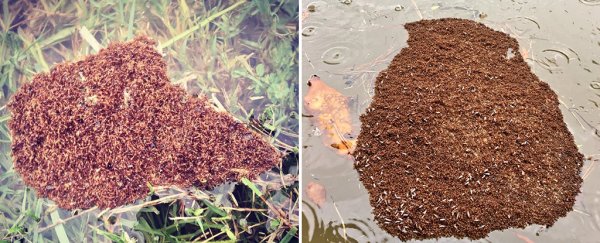Residents of the Houston area affected by Hurricane Harvey have spotted an unusual risk in the floodwaters: colonies of fire ants that have joined together to form floating rafts.
Fire ants are an invasive species native to South America, and they have successfully colonised the southern US. Whenever a major storm blows through, bringing flooding, these ant rafts appear.
To escape floodwaters, the venomous insects quickly link together, with the queen and larvae at the centre of the raft.
The ants mesh themselves together tightly enough to trap air in the middle, with the ants on the bottom knitted so tightly that water can't get through.
Pro tip: Don't touch the floating fire ant colonies. They will ruin your day. #Harvey pic.twitter.com/uwJd0rA7qB
— Mike Hixenbaugh is mikehixenbaugh.com on BlueSky (@Mike_Hixenbaugh) August 27, 2017
The raft mutates as it goes, with ants travelling across the top and joining the stationary layer on the bottom, according to one study of the dynamics of these structures.
The authors of that study wrote that some of these rafts may have more than 100,000 stinging ants.
Fire ants can survive in these structures for weeks or even longer, though they're constantly seeking new dry land to colonise as they float.
For that reason, boaters need to be careful to avoid the rafts. The ants will climb onto a boat and can even climb aboard via a stray oar if given the opportunity, according to a publication by the Texas A&M AgriLife Extension Service.
Fire ants form a protective island as they float out the #Houston flood pic.twitter.com/UBORwAzA4R
— Omar Villafranca (@OmarVillafranca) August 27, 2017
While an isolated sting is painful, it's usually only serious for people with an allergy. But a whole colony can deliver real damage.
The National Weather Service is warning people in Texas and Louisiana to avoid the flood water for other reasons as well - it may carry an electric charge from downed power lines, or hide dangerous debris.
As for the ants, they're just trying to escape too, but if you come across a colony, steer clear.
This article was originally published by Business Insider.
More from Business Insider:
